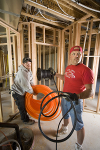
It’s no secret that recent times have not been kind to the construction market. But a recent exclusive survey conducted by Clear Seas Research paints a brighter picture for the radiant heating industry.
According to the study, nearly half (47 percent) of contractors and flooring installers surveyed experienced an increase in the number of their radiant heat projects last year compared to previous years (the average number of projects worked on was nine in a 12-month period). Only 22 percent reported a decrease in the amount of radiant work they performed.
“Radiant jobs are definitely picking up,” saysFrank Mazzarese, Southwest and West Coast business development manager for Zurn PEX. “We never saw the drop down that residential plumbing did. The radiant side kind of stayed up while plumbing jobs dropped down a lot.”
Watts Radiant Hydronic Engineering ManagerAlex Greenadds that energy efficiency and the green movement are two specific factors that have helped the radiant landscape.
The survey, conducted during the summer of 2009, encompasses radiant heat contractors and installers who worked for a company with an average of 19 employees and average revenues of nearly $2 million. Three of every four survey participants (74 percent) who work on hydronic radiant heat projects are plumbing contractors/installers. A majority of those polled (54 percent) reside in either the Midwest (28 percent) or West (26 percent).
What Customers Say
Those contractors and installers who did experience increases in radiant heat requests reported customer awareness of radiant technology (63 percent) and comfort (61 percent) as the main drivers behind the uptick. Cost-effective heating (45 percent) is also a prevalent response.“We’re selling it as comfort,” saysMike Bernasconi, Central Cooling & Heating’s (Woburn, Mass.) vice president of piping operations. “There is the energy-savings aspect, but the vast majority of what we do is based on comfort.”
“It’s the same as it has always been. It’s comfortable,” says Taco Contractor Training ManagerJohn Barba. “It’s the best way to heat a basement. If you’re redoing a bath, why not put in radiant? I’d rather be warm, wet and naked than cold, wet and naked any day of the week.”
Word-of-mouth is one major factor that falls under that customer-awareness-of-technology umbrella.
“It’s a ‘My neighbor has it, I want it’ type of thing,” explainsJustin Johnson, the owner of Sprinter Heating & Hydronics in Rigby, Idaho. “It’s a lot of word-of-mouth out here. And the first words out of customers’ mouths are, ‘I can’t afford it.’ But when you compare apples to apples with them, you usually get a deal out of it.”
Residential vs. Commercial
The survey also reveals contractors and installers mainly worked on residential radiant jobs (49 percent residential hydronic and 38 percent residential electric), compared to radiant commercial jobs (12 percent between commercial hydronic and electric). Forty-eight percent of respondents reported an increase in the number of hydronic residential projects over previous years.“It’s what kind of keeps us busy,” Johnson says. “We’re starting to do a lot of remodels and retrofitting with residential radiant. Homeowners may be dissatisfied with their homes and they remodel, and part of that remodeling is installing some sort of radiant system.”
The survey also reveals new construction projects made up roughly half (49 percent) of hydronic radiant heat projects worked on in the previous 12 months, while an additional 38 percent came from remodel and retrofit projects.
“We’re doing the new construction. The high-end hasn’t changed, but the mid-range has kind of gone away,” Bernasconi says. “The total remodeling market is pretty much still there and seems to be real strong - that and the replacement market. They’ve kind of replaced the mid-range construction. Utility rebates and tax credits have something to do with it. It’s been amazingly strong - much better than last year.”
Watts Radiant’s Green, however, has noticed a distinct increase in commercial radiant jobs.
“In general, commercial has really picked up,” Green says. “We’ve got two guys working almost consistently on commercial designs. I’m guessing it has a lot to do with the stimulus money, and we’re seeing a noticeable change in the number of government and military radiant jobs.”
Public buildings (37 percent) and office and bank buildings (31 percent) topped the list of the most common commercial applications for radiant heat, while 77 percent of contractors and installers polled said energy savings and comfort for occupants (66 percent) were the two leading reasons building owners decided to install radiant heat.
Size Of Radiant Jobs
While interest in radiant heating has increased, the survey reveals the scope of jobs has been relatively small in nature.Eight of 10 respondents to the survey reported the average project cost for a typical residential remodel hydronic radiant heat project was less than $20,000. Fifty percent of those polled said they did hydronic radiant residential remodels that fell in the $5,000-$14,999 range, while 22 percent said a typical job they did was less than $5,000.
Two-thirds of those surveyed reported a typical new construction hydronic radiant system ran less than $20,000.
“You’ve still got radiant jobs going on regardless of the economy in what I would call the ‘rock star’ homes,” Barba notes. “In what would be considered the ‘normal’ people’s homes, you are seeing the retrofits and the remodels.”
Johnson also subscribes to the “rock star” theory, but throws in an added caveat.
“I think people that have money have even more money now, but they are smarter with their money and are more willing to spend and widen their energy choices vs. going out and buying a boat or something else,” he says.
On the commercial end, those queried reported 30 percent of the commercial hydronic jobs they did fell below $5,000 - but the overall median cost for a common commercial job ($20,000-$24,999) was higher than both the median residential remodel hydronic job ($10,000-$14,999) and the new construction residential hydronic job ($15,000-$19,999).
Nearly eight out of 10 respondents (76 percent) reported their company generated less than $150,000 in total sales from radiant heat projects over the last year.
Branching Out
Contractors and installers surveyed reported one in two radiant projects they worked on over the past year was strictly radiant, while one in four projects used a combination of radiant and other hydronic-heating materials.But contractors and manufacturers see that trend quickly changing. “I would say very few projects are completely radiant,” Bernasconi says. “They are partially radiant and partially anything else, such as hydro-air, geothermal or heat pumps. I would say less than 10 percent of our radiant projects are totally radiant.”
Barba adds: “It’s getting close to where it’s time to stop talking about radiant being separate from a heat system. A lot of systems that are going in are not all radiant or all something else, but they are a mixture of different applications. It all falls under the big ‘H’ in HVAC.”
In terms of technology, 43 percent of contractors and installers surveyed said they use condensing boilers as the heat source for their hydronic radiant projects, while more specifically 56 percent said they use high-efficiency, modulating condensing boilers. Twenty-six percent said they use cast-iron, gas-fired boilers.
On the installation side, 67 percent of respondents noted they installed hydronic radiant products on slab on grade, while 52 percent said they used poured underlayment, 47 percent said they used staple-up and 42 percent said they installed via a subfloor engineered radiant panel.
Information Superhighway
Contractors and installers overwhelmingly turn to trade magazines more about current products available in the radiant heat market. The survey also cites information from wholesalers (48 percent), manufacturer websites (46 percent) and peers in the trade (43 percent) as prominent sources of new radiant information.“I read every possible thing I can get my hands on,” Bernasconi says. “I read Plumbing & Mechanical. I try to go to a couple of major trade shows, but most of it comes from reading. I get a ton of it in my mailbox and I read it all.”
Johnson, due to his location in Idaho, uses a variety of sources for his information. “We rely a lot on suppliers because of where we are at,” he says. “I check out Plumbing & Mechanical, and I check on the Solar Heating Report (a quarterly supplement in PM and pme) quite a bit. I do online searches for the rest of it. I have my keywords. I’ll type in ‘latest radiant job’ or something like that.”
Bernasconi says he would like to see more information available on wireless devices. “I was one of the first people to get an iPad,” he says. “Half the stuff I get I try to read on that. I’d like to see stuff be more Internet-based for things like an iPhone or iPad. It makes it easier.”
Product-wise, 82 percent of those surveyed said the quality of hydronic radiant tubing product is the driving factor in the decision of which manufacturer’s product to install. Contractors and installers, according to the study, are least influenced by homeowner requests, designer/architect specs and/or sales promotions/incentives. However, if a competitor brand offers better product quality and easier installation, roughly one in two respondents reported they would likely switch from their preferred brand.
Radiant Down The Road
Barba sees a bright future for the radiant heating industry due to it being similar to the political marble cake model where different forces work together to create policies.“With a marble cake, everybody works together to reach a goal,” Barba explains. “The heating business is not a layered cake. All of the elements mix together into a marble cake. If homes have forced air upstairs but radiant in the basement or in the bathroom, that’s a great system. It’s economy of installation with economy of operation and comfort. Why wouldn’t radiant continue to be popular? It works. It makes sense and people like it. It’s comfortable and it solves problems.”
Johnson feels future growth in radiant heating will continue to be linked to the customer’s pocketbook.
“With utility costs, people are always looking for cheaper ways to heat and cool their homes,” he says.


